www.ceramics.org | American Ceramic Society Bulletin, Vol. 100, No. 8 4 Celebrating 100 years news & trends By Elayaraja Kolanthai, Udit Kumar, and Sudipta Seal (University of Central Florida) and Kenneth W. Liechty (University of Colorado School of Medicine) In this world of constant medical pre- dicament, scientists are constantly in pur- suit of new therapeutics to prevent and cure diseases. However, the process of bringing a new molecule to market takes nearly 10–15 years and requires a huge investment in excess of billions of dollars. In the last two decades, ribonucleic acid (RNA)-based therapeutics have start- ed to play a vital role in medicine. RNA- based treatments regulate gene expression to treat a plethora of diseases and ail- ments. They offer the ability to minimize production cost and time of new thera- peutics while ensuring safe clinical use. The vaccines developed by Pfizer- BioNTech and Moderna to treat COVID-19 infection are a current and significant example of the wonders offered by messenger ribonucleic acid (mRNA) vaccines. The projected market value of mRNA vaccines and therapies is slated to surpass $9.41 billion this year.1 One type of RNA-based therapeutic that has long been discussed but remains far from commercialization is microRNA (miRNA). miRNA, not to be confused with mRNA, is a subsection of noncoding RNA that is the most common regulator of gene expression. Globally referred to as the “next-generation” of therapeutics, miRNA-based treatments gained signifi- cant recognition due to their potential in addressing the “genetic framework” of the disease by targeting specific mRNAs for suppression or degradation. In 2020, the market value for miRNA therapeutics accounted for an estimated $854.6 million, and the compound annual growth rate will rise about 19.8% from the years 2021 to 2028.2 This potential can be attributed to miRNA’s mechanism of targeting specific mRNAs, which leads to potential biomedical applications either as diagnostic tool or active therapeutics. It is a diagnostic tool when there is a dysregulation of particu- lar miRNA. It is an active therapeutic in diseases where alteration of gene expres- sion is beneficial, such as in cardiovas- cular, Alzheimer’s, rheumatoid arthritis, immune disorders, diabetics, and cancer. Further, it has been used to prevent inflammation during wound healing. Overall, the field of miRNA diagno- sis and treatment is a promising area within gene-based medicine. In particu- lar, wound healing applications have emerged as one of the more promising uses of this technology. Wounds are classified as either acute or chronic depending on the time of the wound healing rate. An acute wound is an injury that occurs in a shorter dura- tion after an initial accident or surgery and normally heals with the possibility of natural scarring. A chronic wound is the anomalous healing of the acute wound as a result of comorbid condi- tions like diabetes, pressure ulcers, inju- ry, larger wound size, or venous stasis. About 6.5 million patients in the United States suffer due to chronic wounds. Among them, patients more than 65 years old with diabetes (18%) develop nonhealing foot ulcers. According to the National Institute of Health in the U.S., the cost for treatment of diabetic foot ulcers per year alone approximates to around $9–13 billion. Wound healing is a complicated process that involves the temporal and integrated regulation of multiples phases of healing. Following initial hemostasis, the subsequent phases consist of inflam- mation, proliferation, and remodeling. If this sequence becomes dysregulated, impaired healing or a complete failure of wound healing can occur. The development of novel miRNA- based diagnostics and therapeutics would have a tremendous impact on chronic wounds. The multiple healing phases are regulated by gene expres- sion, which in turn is regulated by miRNA. Dysregulated gene expression and miRNA have been demonstrated in each phase of healing. Thus, focusing on miRNA wound healing therapy can significantly increase the wound healing speed and improve patients’ health. However, many factors hinder the effective delivery of RNA interference (RNAi) molecules. For instance, when naked RNAi enters an extracellular space, they are prone to the degrada- tion by the endonucleases. Moreover, due to the physiological fluids and the negative surface charge on the cell membrane, the RNAi uptake by the cells becomes hindered and additionally causes many chances of off-target effects. Therefore, many technologies have been implemented for effective delivery of RNAi to preserve the integrity of the molecule in engaging their role and pre- venting (i) off-target effects, (ii) low cell uptake, and (iii) endosomal degradation. Nanoparticles such as gold, silver, and various bioceramics (e.g., hydroxyapatite, cerium oxide, silica) are currently being used to overcome this hindrance. MicroRNA in medicine: A new therapeutic frontier in wound healing A schematic illustration of bioceramic oxide (e.g., ceria, silica) and metal (e.g., gold, silver) nanoparticles delivering therapeutic miRNA molecule to a cutaneous wound. Credit: Ryan Dickerson, University of Central Florida
(c) 2024 American Ceramic Society. All Rights reserved.




















































